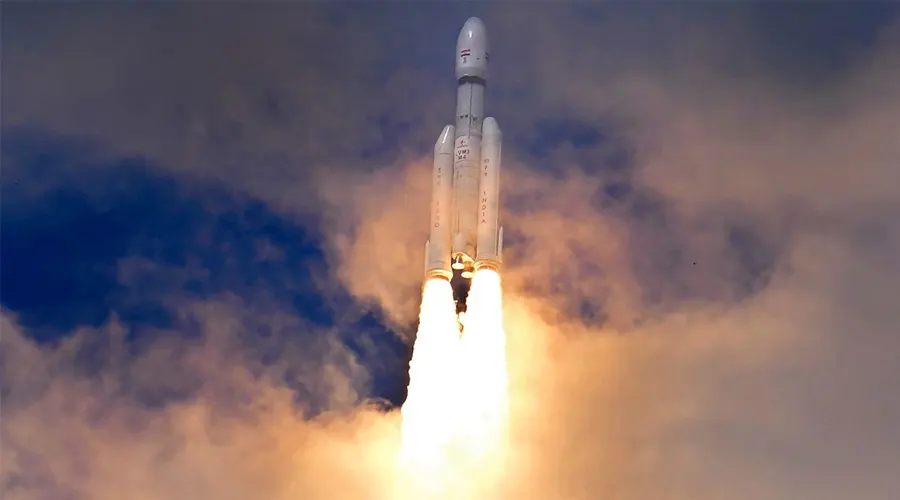Chandrayaan-3 Rocket Launched
India’s third moon mission, Chandrayaan-3, was successfully launched onboard a Launch Vehicle Mark-3 (LVM-3) rocket from the second launch pad at the Satish Dhawan Space Centre in Sriharikota at 2.35 pm on July 14.
If successful, the mission will make India the fourth country to achieve a controlled landing on the moon, after Russia, the United States, and China.
The moon lander Vikram is perched on a Mark 3 heavy-lift launch vehicle -- dubbed the Bahubali rocket.
The journey from Earth to the moon for the spacecraft is estimated to take about a month and the landing is expected on August 23. Upon landing, it will operate for one lunar day, which is approximately 14 Earth days. One day on the Moon is equal to 14 days on Earth.
The Chandrayaan-3 will have three major components — a lander, a rover, and a propulsion model. It will be using the Orbiter from Chandrayaan-2 which still exists in the lunar atmosphere.
Vikram is meant to have a safe, soft landing. The lander will then release the rover Pragyan, which will roam the moon's surface for a lunar day -- equal to 14 earth days -- and conduct scientific experiments.
The latest iteration of the Chandrayaan comes four years after an earlier attempt failed, with the ground crew losing contact moments before landing.
The ISRO's second lunar mission Chandrayaan-2 failed while attempting to land in 2019. However, to avoid past failures, ISRO has corporate a series of changes in the upcoming mission.
"The main gap in the last Chandrayaan-2 mission was that there were off-nominal conditions that were initiated in the system. Everything was not nominal. And the craft was not able to handle the off-nominal condition for a safe landing," ISRO Chief S Somnath told in an exclusive interview.
This is India’s second attempt at soft-landing robotic instruments on the lunar surface after the previous attempt, Chandrayaan-2, failed in 2019.
After the successful launch, ISRO Chairman S. Somanath said the next 42 days are crucial. “As per the nominal programme, we will have five earth-bound maneuvers that will end on July 31. After that, we have the trans-lunar insertion, which will take place on August 1. After that, it will be captured by the moon. This will be followed by the separation of the propulsion module and the lander module on August 17. “The landing is currently planned on August 23 at 5.47 pm IST, if everything goes as per plan,” he added.
Hailing the launch, Prime Minister Narendra Modi tweeted: “Chandrayaan-3 scripts a new chapter in India’s space odyssey. It soars high, elevating the dreams and ambitions of every Indian... This momentous achievement is a testament to our scientists’ relentless dedication. I salute their spirit and ingenuity!”
Minister of State Jitendra Singh, who was present at the launch, said, “It is indeed a moment of glory for India. Thank you team ISRO for making India proud... Today is also a day of vindication: vindication of the dream Vikram Sarabhai had six decades ago.”
Around 16 minutes after the LVM-3 lifted off, the spacecraft separated from the rocket. It was an integrated module comprising the propulsion module, the lander module, and the rover. It entered into an elliptic parking orbit (EPO). This orbit’s closest approach to Earth was around 170 km and farthest, at 36,500 km.
The Chandrayaan-3 consists of an indigenous propulsion module (PM), and a lander module (LM). The mission’s objective is to develop and demonstrate new technologies required for interplanetary missions.
The propulsion module will carry the lander (containing the rover) from the EPO around Earth to a circular orbit around the moon, at an altitude of 100 km. This module also carries an instrument called ‘Spectro-polarimetry of Habitable Planetary Earth’ (SHAPE), to study spectral emissions coming from Earth.
According to ISRO, the lander can soft-land at a specified lunar site and deploy the rover. The rover will perform in-situ chemical studies of the lunar surface as it moves around. The lander also has scientific instruments to study the lunar surface and subsurface.
The propulsion module will execute a series of maneuvers over the next month to sling itself towards the moon and be caught there by the moon’s gravity. Once it has been captured into a lunar orbit, the lander will detach itself and attempt to soft-land on the moon’s surface.
The Chandrayaan-3 mission’s objective is to develop and demonstrate new technologies required for interplanetary missions.


Comments (0)